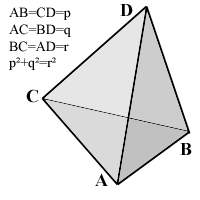
The pictured tetrahedron has four identical rectangular (i.e., right-angled or pythagorean) triangles as faces, with
AB=CD=p,
AC=BD=q,
AD=BC=r,
and p²+q²=r².
What's its volume, as a function of p, q and r?
Working with my spheres, I suddenly found out an easier solution. ABC
and ABD are identical triangles that share AB. We can fix C in place
and rotate ABD (leaving AB fixed) until CD=AB -- and this happens only
when D and C are in the same plane as A and B.
|
|
Posted by e.g.
on 2004-04-26 15:42:41 |
 The pictured tetrahedron has four identical rectangular (i.e., right-angled or pythagorean) triangles as faces, with
The pictured tetrahedron has four identical rectangular (i.e., right-angled or pythagorean) triangles as faces, with


